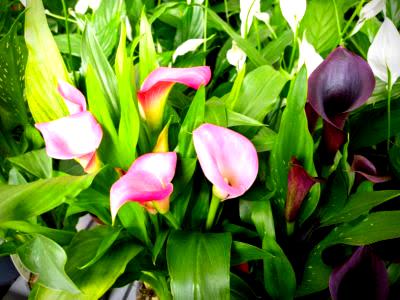Calla Lily Care - Tips on Growing Calla Lilies
Although not considered a true lily, the lily (Zantedeschia sp.) is an extraordinary flower. This beautiful herb with a multitude of colors grows from rhizomes and is ideal for use in beds and borders. You can also grow calla lilies in containers as pot plants, outdoors or in a sunny window. Here are a few tips on growing calla lilies that will make them shine in your garden.
Tips on Growing Calla Lilies Growing calla
lilies is easy. These plants usually do not require a lot of attention. The only important thing to consider when growing calla lilies is proper planting and location. Caring for calla lilies requires that they be planted in loose, well-drained soil. They prefer to be in full sun or partial shade in hot climates. Calla lilies are usually planted in the spring. However, wait until danger of frost has passed and the soil has warmed sufficiently before planting calla lilies.
Calla lilies should be spaced about 4 inches (10 cm.) and about one foot (0.5 m.) apart for better results. After planting, the area should be well watered. Calla lilies enjoy being kept moist and also benefit from a monthly dose of fertilizer throughout the growing season.
Caring for Calla Lilies
As with planting, nothing much is required to care for lilies other than watering and fertilizing them. An adequate layer of mulch around the plants will help keep the area moist and weed-free. Calla lilies need a dormant period after flowering has stopped. During this time you should avoid overwatering to allow the plant to die.
If you are growing calla lilies in containers, stop watering and move the plant to a dark area after the leaves have faded. Regular watering can resume in two to three months. Although calla lilies can stay in the ground year-round in warmer climates, they should be removed and stored in cooler areas.
Caring for Calla Lilies Over the Winter
Dig up the rhizomes and shake off the soil in the fall, usually after the first frost. Allow the rhizomes to dry for a few days before storing them for the winter. Calla lilies should be stored in peat moss and preferably in a dark, cool, dry place until higher temperatures return in the spring. Likewise, you can choose to start your lilies indoors in late winter and transplant them outside in the spring. Calla lilies can also be divided when removed or during dormancy.
Growing calla lilies is easy and care for calla lilies is minimal at best. Choosing to grow calla lilies in the garden or as a houseplant is a great way to add color to any space. These tips on growing calla lilies will help you enjoy these beautiful blooms even more.
Green Calla Lily Flowers - Causes of Calla Lilies with Green Blooms
The elegant calla lily is one of the most recognizable flowers in cultivation. There are many colors of calla lily, but white is the most used and part of both wedding celebrations and funerals. Perennial flowers are a florist's dream, and miniature plants in pots adorn homes all over the world. There are a few calla flower issues, but a common occurrence is the appearance of green blooms. This may be due to growing problems, lighting or the age of the flowers.
If you're not growing the Calla Lily
'Green Goddess' calla variety with Green Blooms, you may be surprised at the green calla lily blooms. Calla lilies are not true lilies. They are from the same family as Jack on the pulpit. Flowers are not what they seem. The leaves of the flower are called spathe. Spathes are modified leaf structures that fold around the spadix. Spadix bears tiny true flowers.
Green spots are often the result of low light situations. Calla pox problems can also be caused by excess nitrogen. Flowering plants need balanced fertilizers or those that are slightly higher in phosphorus. High levels of nitrogen can delay flower formation and cause green lily blooms.
Green Calla Lily Flowers on Young Plants
It is perfectly normal for some varieties of young calla plants to have green spots. The buds start out green or open with green stripes and change color as they open and mature. Since this natural formation will correct itself over time, it is not considered among the calla flower problems.
Plant callas in bright sunlight where the soil drains well. In dim light, plants may have difficulty coloring and may remain greenish.
Provide supplemental watering during flowering periods to encourage healthy plants. Callas are originally from Africa and require high temperatures to encourage flowering. They bloom most often in temperatures of 75 to 80 degrees F (24-27 C). In favorable conditions, calla lilies bloom all summer, and the flowers last up to a month on the plant.
Why Do Calla Flowers Turn Green?
Reversing the already colored calla flowers, the gardener asks, “Why are the calla flowers turning green?” It makes him wonder. The plant is a perennial in many regions and goes dormant as autumn approaches. This causes perennial flowers to change color, often green and then brown. Green blooming lilies are a normal part of the mature plant's life cycle.
The plant begins to energize its leaves, which collect energy to ensure the next season's bloom. When the flowers are loose and green, cut them back so the plant can use all its resources to nourish the rhizomes. Dig up rhizomes in colder areas and store them in a ventilated bag set in peat or sphagnum moss. Replant the rhizomes in early spring when the soils are workable.

